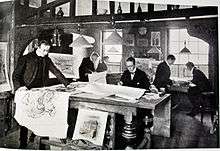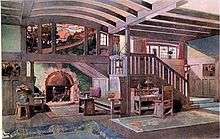Leonard Wyburd

%2C_by_Henry_Weigall_Jr_(1829-1925).jpg)

Leonard Francis Wyburd RA (12 June 1865 – 17 January 1958)[1] was a British painter, Interior designer and noted furniture designer. He was broadly part of the Arts & Crafts movement, and the head of Liberty's Furnishing and Decoration Studio from its foundation in 1883 until he left in 1903.[2]
Early life
Wyburd was the son of the painter Francis John Wyburd (1829–1909) and Jemima Wyburd née Corbould (1840–1913).[1] His grandfather Edward Henry Corbould was appointed "instructor of historical painting to the royal family" from 1851 and taught Queen Victoria and her family painting and drawing.[3]
Career
Liberty, under its founder, Arthur Lasenby Liberty, opened a store in London's Regent Street in 1875, and was already known for its fabrics and imported Asian furniture. In 1883, it established a "Furnishing and Decoration Studio" under the direction of Wyburd, then aged only 18.[2] Wyburd's Spanish Moorish and Arab-influenced furniture designs proved to be both fashionable and popular.[4][5][6]
By the late 1890s, Wyburd was at the forefront of European furniture design, combining elements of Art and Crafts, Art Nouveau and other medieval English allusions. Liberty furniture was typically of solid oak or mahogany, well yet simply made, sometimes with small cut-outs, stained glass insets or elaborate beaten copper hinges.[5][6] Wyburd's designs were often given Saxon or Scottish names. One was the Athelstan chair, of around 1899.
The Liberty Studio closed in 1905, but Wyburd had already left in 1903 to establish his own Wigmore Street studio in London.[5][7] His later commissions included redesigning the drawing room at Rosslyn Tower, St John's Avenue, Putney, London.[8] He also created a design for an interior at Riverside House in 1904 which featured a selection of typical Arts and Crafts furniture. It has been said that but for his apparent reluctance to seek recognition for his work, he might today have the same level of recognition as Charles Voysey and Baillie Scott.[7]
In later life, Wyburd was a London antique dealer, which trade he carried on for many years.[3]
Personal life
On 14 July 1900, Wyburd married Eleanor Oldershaw Bathurst (1876–1976), at St Mary Abbots, Kensington, London. They had two sons, Henry Neville Corbould Wyburd (1901–1960) and Derek Bathurst Wyburd (1904–1992).[1]
References
| Wikimedia Commons has media related to Leonard Wyburd. |
- 1 2 3 "Leonard Francis Wyburd". jjhc.info. Retrieved 26 March 2014.
- 1 2 "The Regent Street style" by Paul Overy in The Times, 13 August 1975, p. 10.
- 1 2 "Mr. Leonard Wyburd", correspondence, The Times, 31 January 1958, p. 13.
- ↑ "English Arts & Crafts Sideboard attributed to Leonard Wyburg, ca. 1905". PBS.org. Retrieved 26 March 2014.
- 1 2 3 "Liberty Leonard Wyburd watercolour interior 2". Hill House Antiques. Retrieved 26 March 2014.
- 1 2 Miller and Bace, Judith and Jill; Rago, David; Perrault, Suzanne (2004). Art nouveau (1st American ed.). London: DK Pub. p. 49. ISBN 978-0756603489.
- 1 2 "Liberty & Co A Huge Arts Centre". artscrafts.org.uk. Retrieved 26 March 2014.
- ↑ "Property: With cellars". The Independent. Retrieved 23 March 2014.